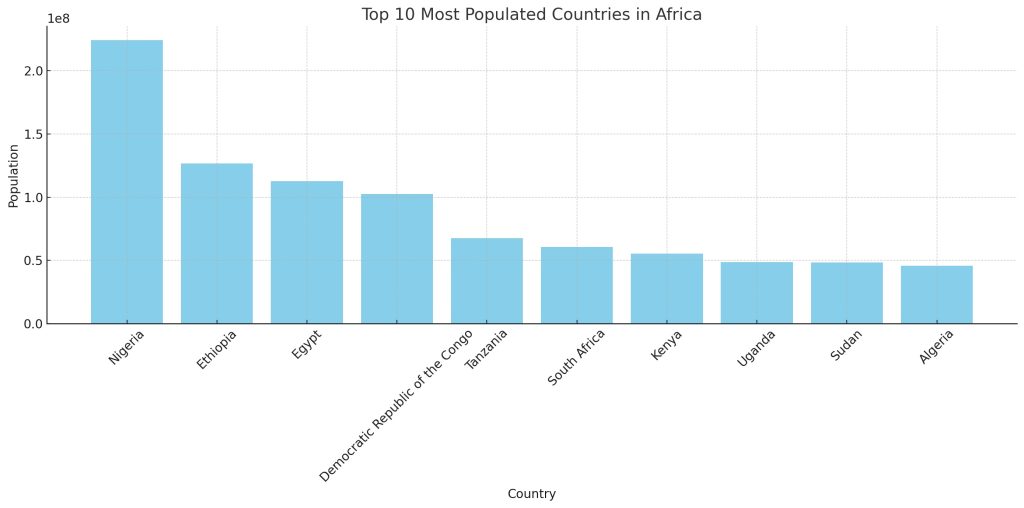There are 8.1 billion people in the world today, and this number is expected to reach 8.5 billion in three years. More than half of the predicted population expansion is expected to come from just eight nations: the Democratic Republic of the Congo, Egypt, Ethiopia, India, Nigeria, Pakistan, the Philippines, and Tanzania. Africa’s current population totals 1,463,378,937, 17.89% of the world population.
Africa’s large population has been advantageous to its economy. A large population means the continent has a large labour market. The continent has the youngest population, with a median age of 18.4%. This also means rapid economic growth will occur as people mature and enter the labour market. A large population also creates a larger domestic market for the economy.
However, having a large population isn’t always easy. It can put pressure on the available resources, especially if the country is a small country. This can lead to challenges like high unemployment and poverty rates. In 1979, China implemented a “one child” policy to curb its growing population after the country realised its population outweighed its available resources. This policy was, however, abolished in 2015. Although most African countries are classified as developing countries, the continent currently has the fastest-growing economy in the world. Africa’s populated countries have the opportunity to harness its growing human capital for economic growth. These are the 10 most populated countries in Africa.

| Ranking | Country | Population |
|---|---|---|
| 1. | 🇳🇬 Nigeria | 224 Million |
| 2. | 🇪🇹 Ethiopia | 127 Million |
| 3. | 🇪🇬 Egypt | 112 Million |
| 4. | 🇨🇩 DR Congo (DRC) | 102 Million |
| 5. | 🇹🇿 Tanzania | 67 Million |
| 6. | 🇿🇦 South Africa | 59 Million |
| 7. | 🇰🇪 Kenya | 55 Million |
| 8. | 🇺🇬 Uganda | 49 Million |
| 9. | 🇸🇩 Sudan | 48 Million |
| 10. | 🇩🇿 Algeria | 46 Million |
1. Nigeria
Nigeria is Africa’s most populated country, with 224,275,240 people, and the sixth most populated nation globally. Nigeria currently represents 2.35 per cent of the world´s total population, which means that one in every 43 people on the planet is a resident of Nigeria.
Nigeria’s population growth sprout really started in the 1980s, after child mortality dropped rapidly. During that period, the country experienced the highest growth rate. Hence, Nigeria has a large young population. Unsurprisingly, Nigeria is home to 371 ethnic groups with over 500 languages. Over 50% of its population lives in the urban areas. However, Nigeria’s large population has been known to work to its advantage. The West African country is one of the biggest economies in Africa. Its human capital plays a significant role in its economic growth. Nigeria’s total population is estimated to reach 256,86 million by 2029, a 12% increase from its current number.
2. Ethiopia
With 126,809,429, Ethiopia is Africa’s second most populated country and 11th globally. As of 2022, Ethipoia had 61.4 million women and 61.98 million men. Ethiopia used to be lauded as one of the fastest-growing economies in the world, with an average GDP growth of 10.8%. The country’s poverty rate fell to 23% in 2015. However, the country began to experience several political tensions and droughts that significantly affected its economic growth. As of 2023, Ethiopia is one of the poorest African nations, with a per capita gross national income of $1.020. Ethiopia’s population is estimated to reach 150 million. However, Ethiopia has an advantage – over 70% of the country’s population is under 30. Last year, Ethiopia began a three-decade National population policy to align economic planning with its rapid economic growth.
3. Egypt
As of 2024, there are 112,870,951 people living in Eygpt. It is the third most populated country in Africa and the 14th globally. Notably, Eygpt also has the second-biggest economy in Africa. As of last year, individuals from the ages of 15 to 64 who are able and willing to work constituted 61.7% of the country’s total population. While citizens older than 64 made up 3.9% of the population, and people below 14 years old accounted for 34.2% of the population. Last year, Eygpt’s population growth slowed by 1.4%, which is the lowest rate in decades. This is believed to be a result of the authorities launching a campaign called “Deux, c’est assez” (two is enough” in 2019.
4. Democratic Republic of the Congo
The Democratic Republic of the Congo (DRC) has a population of 102,556,950. It is the 15th largest globally. The high population growth in the DRC can be attributed to an increased life expectancy and a high birth rate. The Life expectancy in the DRC increased from 49 years in 1995 to 62 years in 2023. Congolese women give birth to an average of 6.2 babies in their lifetimes, four births more than the global average of 2.3 babies. By 2050, the DRC is estimated to have 215 million people, joining the list of the world’s 10 most populated countries. Despite its large and growing population, The DRC is a nation rich in natural resources. However, lack of infrastructure development and good governance has consistently hindered the DRC’s economic growth.
5. Tanzania
Tanzania has a population of 67,612,351. It is the 5th most populated in Africa and the 22nd globally. Dar es Salaam, the former Tanzanian capital, is one of the world’s fastest-growing cities. The number of people in the economic hub is expected to double by 2050 to more than 10 million. In 2022, Tanzania’s fertility rate is an estimated 4.66 births for each woman, double the global average. The president, Samia Suluhu Hassan, called for better family planning, saying the high number of births will put pressure on education, healthcare, and food. However, current efforts to manage population growth will only be felt after 2050.
6. South Africa
South Africa is the 6th most populated country in Africa, with 60,462,959. It is the 24th globally. Interestingly, South Africa currently has the biggest economy in Africa. Much like Nigeria and Egypt, its large population plays a significant role in its economic prowess. Older people make up 5.9% of South Africa’s population, and children 28.6%. This means South Africa has a higher working-age population, unlike many high-income countries. Despite being South Africa’s smallest province, Gauteng, which includes Johannesburg, is home to nearly 16 million people. Households comprising two to three members make up 39.2% and are more common in urban areas. On the other hand, households with six or more people amounted to 19.3 per cent in rural areas.
7. Kenya
Kenya is popular for several things. For example, they are known for producing some of the world’s best runners. In the last few years, the country has become a regional hub for information technology and communication services on the continent. What most people do not know about the East African giant is that, with 44 recognised tribes, Kenya is also among the most ethnically diverse countries on Earth. Kenya is home to 55,197,515 people, making it the 7th most populated in Africa and the 26th globally. Kenya’s population also significantly influences its technological and economic advancements. The median age in Kenya is only 20, and nearly three-quarters of the population, about 37.5 million people, are under 30. Kenya’s population is predicted to about double by 2050.
8. Uganda
Available data from WorldPopulationReview shows that Uganda’s population totals 48,700,835, making it the 8th most populated country in Africa and 30th globally. However, Uganda is set to carry out a census in May 2024. It will be the sixth in the post-independence period. According to current data, 8.5 million people live in Kampala’s capital and largest city. The total population in Uganda was forecast to increase continuously between 2024 and 2029 by 9.1 million people. However, the national census set to be held next month will determine whether the East African nation is on track.
Related Articles:
9. Sudan
The current population of Sudan is 48,219,383, making it the 9th most populated country in Africa and the 31st globally. The annual population growth in Sudan decreased by 0.1 percentage points (-3.7 per cent) in 2022. However, the last two years recorded a significantly higher population growth. The total population in Sudan is predicted to continuously increase between 2023 and 2028 by a total of 6.6 million people. However, in the last year, Sudan has undergone one of the worst armed conflicts. Three-quarters of South Sudan’s population continues to face starvation. And millions face severe levels of hunger as a result of the power struggle.
10. Algeria
Algeria has a population total of 45,667,552, making it the 10th most populated in Africa and the 34th globally. In 2022, the annual population growth in Algeria declined to 1.63 per cent. As a result, the population growth in Algeria saw its lowest number in 2022. 91% per cent of the Algerian population lives along the Mediterranean coast on 12% of the country’s total land mass. Meanwhile, 75% of the population lives in urban areas. There are approximately 22.04 million female and 22.86 million male population inhabitants. As of April 2024, Algeria is set to displace Nigeria as the third-largest economy.
The Bottom Line
As Africa continues to evolve and expand, its ten most populated countries exemplify the dynamic interplay between demographic growth and economic potential. From Nigeria’s robust economic contributions and burgeoning population, which ranks it the sixth most populous nation globally, to Algeria’s strategic urban concentration along the Mediterranean, these nations are not just demographic heavyweights but also pivotal to shaping Africa’s economic future. With over 1.46 billion people currently, representing nearly 18% of the global population, Africa’s youthful demographic is its greatest asset. This provides a unique opportunity for sustained economic growth and development, particularly as these nations invest in education, healthcare, and infrastructure to support their growing populations.
However, challenges such as resource management, political stability, and economic diversification remain critical. Effective governance and policies tailored to harness the demographic dividend can help mitigate potential negatives such as unemployment and poverty, which are exacerbated by rapid population growth. As these countries continue to develop, their ability to manage growth sustainably and inclusively will be crucial. The path forward for Africa’s most populated countries is filled with challenges. Still, it is also ripe with opportunities, making the continent a key player in the global economic arena in the decades to come.











